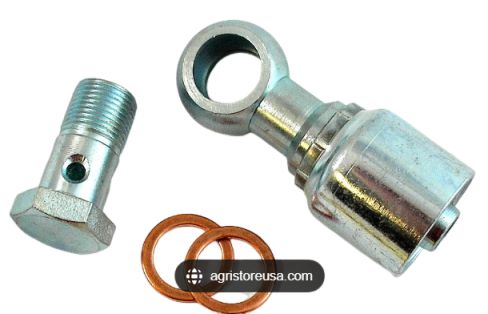Hydraulic banjo fittings are essential components in many hydraulic systems, providing a reliable and leak-proof connection between hoses and components. This comprehensive guide will delve into the intricacies of banjo fittings, covering their design, types, installation, and maintenance.
Whether you’re a seasoned hydraulic technician or a DIY enthusiast, this guide will equip you with the knowledge you need to work effectively with banjo fittings.
What are Hydraulic Banjo Fittings?
Hydraulic banjo fittings are a specialized type of fitting used to connect hydraulic components. They are characterized by their unique design, which involves a bolt, a banjo body, and an O-ring. This configuration allows for a compact and reliable 90-degree connection, making them ideal for tight spaces.
Key Components of Banjo Fittings:
➡️ Bolt: The threaded component that secures the fitting.
➡️ Banjo Body: The curved body that houses the O-ring and creates the 90-degree bend.
➡️ O-Ring: The sealing element that prevents fluid leakage.
Common Materials:
➡️ Steel: A durable and cost-effective option for general applications.
➡️ Stainless Steel: Provides protection against corrosion under challenging conditions.
➡️ Brass: Provides good conductivity and machinability.
How Hydraulic Banjo Fittings Work
1. O-Ring Seal: The O-ring is compressed between the banjo body and the mating surface, creating a tight seal.
2. Fluid Flow: Fluid enters the fitting and flows through the banjo body, making a 90-degree turn.
3. Secure Connection: The bolt is tightened to ensure a secure connection between the fitting and the components it connects.
Advantages of Banjo Fittings:
➡️ Compact Design: Ideal for tight spaces.
➡️ Reliable Sealing: The O-ring provides a strong, leak-proof seal.
➡️ Easy Installation: Simple to install and maintain.
Benefits of Using Hydraulic Banjo Fittings:
➡️ Space-Saving Design: Ideal for compact hydraulic systems.
➡️ Leak Prevention: The O-ring seal ensures a reliable connection.
➡️ Ease of Installation: Simple to install and maintain.
Types of Hydraulic Banjo Fittings
➡️ Standard Banjo Fittings: The most common type, used for a wide range of applications.
➡️ Double Banjo Fittings: Allow for two connections from a single fitting.
➡️ High-Pressure and Low-Pressure Fittings: Designed for specific pressure ratings.
Applications of Hydraulic Banjo Fittings
Here are the different applications of Banjo fittings:
➡️ Automotive: Brake lines, fuel systems, power steering
➡️ Industrial: Hydraulic machinery, pumps, valves
➡️ Agricultural and Construction Equipment: Heavy-duty machinery
Choosing the Right Hydraulic Banjo Fitting
To properly select the right hydraulic banjo fitting, please refer to these factors:
➡️ Material: Select a material that is compatible with the fluid and operating conditions.
➡️ Size: Choose the correct size to fit the components and hose.
➡️ Pressure Rating: Ensure the fitting can handle the maximum system pressure.
➡️ O-Ring Material: Select an O-ring material that is compatible with the fluid and temperature.
Installation Tips:
➡️ Cleanliness: Verify that every part is clear of debris and clean.
➡️ Lubrication: Apply a light lubricant to the O-ring to aid in installation.
➡️ Tightening Torque: Tighten the bolt to the specified torque to avoid over-tightening.
➡️ Alignment: Ensure proper alignment to prevent leaks.
Maintenance and Troubleshooting:
➡️ Inspect for Wear: Check for signs of wear, such as cracks or damage to the O-ring.
➡️ Check for Leaks: Look for any signs of fluid leakage.
➡️ Clean the Fitting: Clean the fitting regularly to remove dirt and debris.
Hydraulic Banjo Fittings vs. Other Types of Fittings
Here is the detailed comparison between banjo fittings and other types of fittings:
|
Fitting Type |
Advantages |
Disadvantages |
|
Banjo Fitting |
Compact, reliable, easy to install |
Can be more expensive than other types |
|
NPT Fitting |
Durable, widely available |
Can be prone to leaks, difficult to install |
|
JIC Fitting |
High-pressure, vibration-resistant |
Requires specialized tools and can be challenging to install. |
|
ORFS Fitting |
Low-profile, leak-proof |
More expensive than other types |
Conclusion
Hydraulic banjo fittings offer a reliable and efficient solution for connecting hydraulic components. By understanding their design, benefits, and applications, you can select the right fitting for your specific needs.
Post time: Nov-14-2024


